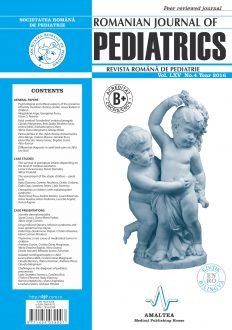SELECT ISSUE

Indexed

| |

|
|
|
| |
|
|
|

|
|
|
|
|
|
|
HIGHLIGHTS
National Awards “Science and Research”
NEW! RJP has announced the annually National Award for "Science and Research" for the best scientific articles published throughout the year in the official journal.
Read the Recommendations for the Conduct, Reporting, Editing, and Publication of Scholarly work in Medical Journals.
The published medical research literature is a global public good. Medical journal editors have a social responsibility to promote global health by publishing, whenever possible, research that furthers health worldwide.
OSTEOPENIA IN CHILDREN WITH MALABSORPTION SYNDROM
Tania Elena Rusu, Evelina Moraru, Laura Bozomitu, Dana Teodora Anton Păduraru, Lucretia Anghel and Aurica Rugina
ABSTRACT
Introduction. Malabsorption syndromes result in the disturbance of bone normal development and function.
Objective. The assessment of bone density in children with malabsorption syndromes. The analysis of risk factors for osteopenia. The correlation between osteopenia, nutritional markers and bone metabolism markers.
Material and method. 118 children with malabsorbtion syndromes of different etiologies, mainly Celiac disease (41 cases) and Cystic fibrosis (14 cases). Bone density was assessed by Quantitative Ultrasonography (QUS) with a Sunlight Omnisense Ultrasonometer 7000P. QUS was performed at two sites – radius (86 cases) and tibia (78 cases). 25hydroxivitamin D was measured in 10 cases by RIA method. Statistical analysis was made using SPSS for Windows.
Results. Osteopenia was present in 32% cases. Decreased bone density at the radius was associated with the celiac syndrome. Osteopenia at the tibia was associated with cystic fibrosis. Osteopenia was more frequent in girls. Osteopenia was related to the duration of the disease. Osteopenia wasn’t related to BMI. Radius Z-score positively correlated to alkaline phosphatase levels and tibia Z-score to serum cholesterol levels. Radius and tibia Z-score negatively correlated with inflammatory marker levels. In children with celiac disease, the value of anti-transglutaminase antibodies was negatively correlated to radius and tibia Z-score values. 25(OH) vitamin D values were deficient in 8 patient and insufficient in 2, but its values didn’t correlate to radius/tibia Z-score. Clinical, biological and radiological signs of rickets were found in 35% of patients with osteopenia.
Conclusions. Osteopenia was found in 1/3 of patients with malabsorption syndromes of the studied group. In 30% of patients, clinical, biological and radiologic rickets signs were present. 25(OH) vitamin D values didn’t correlate with the Z-score. A negative correlation between bone parameters and inflammation markers and anti-transglutaminase antibodies values was observed.
Keywords: osteopenia, malabsorption syndromes, celiac disease
Full text | PDF
